
Peperomia is one of the two large genera of the family Piperaceae. It is estimated that there are at least over 1,000 species, occurring in all tropical and subtropical regions of the world, though concentrated in Central America and northern South America. A limited number of species are found in Africa. The exact number is difficult to tell as some plants have been recorded several times with different names and new species continue to be discovered. Peperomias have adapted to many different environments and their appearance varies greatly. Some are epiphytes or lithophytes, and many are xerophytes (drought-tolerant) either with thick succulent structures or with underground tubers (geophytes). Most species are compact perennial shrubs or vines.

Gentiana acaulis, the stemless gentian, or trumpet gentian, is a species of flowering plant in the family Gentianaceae, native to central and southern Europe, from Spain east to the Balkans, growing especially in mountainous regions, such as the Alps and Pyrenees, at heights of 800–3,000 m (2,625–9,843 ft).
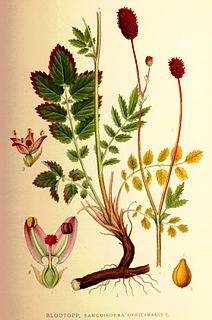
Sanguisorba officinalis, commonly known as great burnet, is a plant in the family Rosaceae, subfamily Rosoideae. It is native throughout the cooler regions of the Northern Hemisphere in Europe, northern Asia, and northern North America.

Hibbertia scandens, sometimes known by the common names snake vine, climbing guinea flower and golden guinea vine, is a species of flowering plant in the family Dilleniaceae and is endemic to eastern Australia. It is climber or scrambler with lance-shaped or egg-shaped leaves with the narrower end towards the base, and yellow flowers with more than thirty stamens arranged around between three and seven glabrous carpels.

Sir Arthur William Hill was Director of the Royal Botanic Gardens, Kew, and a noted botanist and taxonomist.
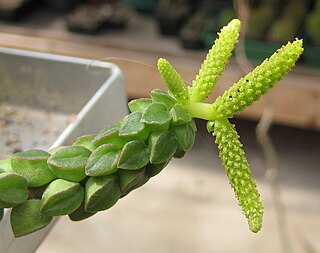
Peperomia columella is a species of plant in the family Piperaceae. The species is endemic to Peru. It grows in dry areas, often in crevices on steep cliffs or in sandy soil. It grows to about 20 cm in height, forming snake-like stems, which carry closely packed succulent bright green leaves. The leaves are truncated, U-shape in cross-section, with epidermal windows on top. It can be kept as a houseplant and has received the Award of Garden Merit by the Royal Horticultural Society.

Pleroma urvilleanum, synonym Tibouchina urvilleana, is a species of flowering plant in the family Melastomataceae, native to Brazil.
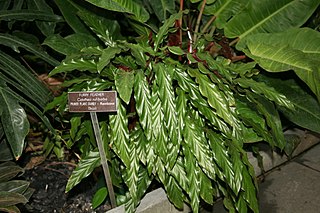
Goeppertia rufibarba, the furry feather or velvet calathea, is a flowering plant in the Marantaceae family, native to Bahia state of northeastern Brazil. The plant's common names are due to its fuzzy, fur-like underleaf texture, which is unusual in its genus. Common as a houseplant, the species requires warm temperatures, shade, and humidity to thrive, and may produce small yellow flowers. It has gained the Royal Horticultural Society's Award of Garden Merit.
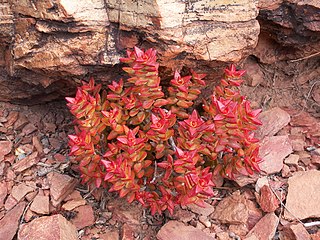
Crassula rupestris, called buttons on a string, is a species of Crassula native to the Cape Provinces of South Africa. It has gained the Royal Horticultural Society's Award of Garden Merit. It is also called bead vine, necklace vine, and rosary vine.

Tetrastigma voinierianum, called chestnut vine and lizard plant, is a species of flowering plant in the genus Tetrastigma, native to Laos and Vietnam, and introduced in Hawaii. It has gained the Royal Horticultural Society's Award of Garden Merit as a hothouse ornamental.
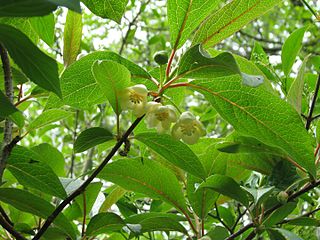
Schisandra grandiflora, called the large-flowered magnolia vine, is a species of flowering plant in the genus Schisandra, native to the Himalayas and Tibet. A deciduous, twining climber, it has gained the Royal Horticultural Society's Award of Garden Merit as an ornamental.

Cyanotis beddomei, the teddy bear vine, is a species of flowering plant in the family Commelinaceae, native to Kerala and Tamil Nadu states in southern India. It has gained the Royal Horticultural Society's Award of Garden Merit. It may be synonymous with Belosynapsis kewensis.
Peperomia velutina is a species of flowering plant in the family Piperaceae, native to Colombia and Ecuador. It has gained the Royal Horticultural Society's Award of Garden Merit as a terrarium or greenhouse ornamental.

Goeppertia crocata, the saffron-coloured calathea, is a species of flowering plant in the family Marantaceae, native to Bahia and Espírito Santo states of eastern Brazil. It has gained the Royal Horticultural Society's Award of Garden Merit as a hothouse ornamental.
Diascia integerrima, the entire-leaved twinspur, is a species of flowering plant in the family Scrophulariaceae, native to South Africa and Lesotho. It is the hardiest of the twinspurs, to USDA zone 6a. It gained the Royal Horticultural Society's Award of Garden Merit in 1995, but the award appears to have been recently revoked.

Phedimus kamtschaticus, the orange stonecrop, is a species of flowering plant in the family Crassulaceae. It is native to China, Korea, Japan and the Russian Far East north to Chukotka, and has been introduced to the state of New York, Norway, Germany, Austria, and the Baltic States.

Hydrangea glaucescens, the Chinese hydrangea vine, is a species of flowering plant in the family Hydrangeaceae, native to southern China, Myanmar, and Vietnam. As its synonym Schizophragma integrifolium it has gained the Royal Horticultural Society's Award of Garden Merit.
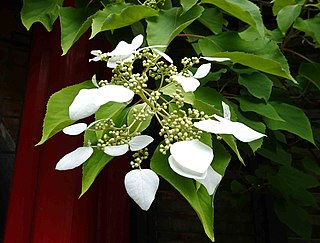
Hydrangea hydrangeoides, the Japanese hydrangea vine, is a species of flowering plant in the family Hydrangeaceae, native to Ulleungdo Island of South Korea, Japan, and the southern Kuril Islands. Under its synonym Schizophragma hydrangeoides its cultivars 'Roseum' and 'Moonlight' have gained the Royal Horticultural Society's Award of Garden Merit.

Peperomia nitida is a species of plant in the genus Peperomia. Its native range is in South America from Brazil to northern Argentina. It can be kept as a houseplant and is sometimes sold as cupid peperomia, or problematically as Peperomia scandens or Peperomia serpens. Peperomia serpens is a separate species with slightly more rounded leaves and its native region reaches further north to Mexico. The title scandens is occasionally applied to both, perhaps because both are vining plants, but officially Peperomia Scandens is considered a synonym for Peperomia serpens.

Peperomia fraseri, commonly known as the flowering pepper, is a species of plant in the genus Peperomia of the family Piperaceae. Its native range covers Colombia and Peru. It has also been introduced to Ecuador and Guatemala.


















